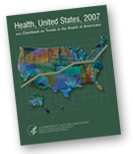Health, United States, 2007
Health, United States Home
Frequently Asked Questions
What is Health, United States?
Health, United States, 2007 is the 31st annual report on the health status of the Nation and is submitted by the Secretary of Health and Human Services to the President and Congress. It contains detailed tables and charts on health status and its determinants, health care resources, health care utilization, and health insurance and expenditures.
What is the special emphasis of Health, United States?
Health, United States focuses primarily on trends over time in health statistics. Comparable data must be available for at least two points in time and available at the national level. In addition to national level data, data are commonly shown by age group, sex, race and Hispanic origin, geography, poverty status, and education level whenever possible.
Why should I look to Health, United States for the answers to my health questions?
Due to the encyclopedic nature of Health, United States, it is a valuable resource for a wide array of health statistics. In addition to presenting key findings from the major data systems of the National Center for Health Statistics, Health, United States presents many unique data analyses not published elsewhere. Health, United States also contains relevant health data from other Federal agencies, and private and global sources.
What are the major components of Health, United States?
Health, United States, 2007 has two major components: A Chartbook on Trends in the Health of Americans that illustrates with text and figures major trends in health and 151 detailed trend tables. The two major components are supplemented by an executive summary, highlights, and an index. The appendixes contain detailed source information, as well as explanations of methods and definitions of terms.
What topics are covered in the chartbook?
Health, United States, 2007 chartbook has 37 graphs and text organized around the following health-related topics: population characteristics, health insurance and expenditures, risk factors, morbidity and limitation of activity, health care utilization and mortality. Each year the chartbook contains a special feature; the 2007 special feature is on access to care.
What topics are covered in the trend tables?
Health, United States, 2007 has 151 detailed trend tables including data on such topics as population numbers by race and Hispanic origin, fertility, natality, mortality, disease prevalence, risk factors, use of ambulatory and inpatient care, health care personnel and facilities, national and state health expenditures, and health insurance coverage.
What information is on the Health, United States web site that is not in the printed book?
The website includes several additions to the printed book, including:
- Additional years of data for selected tables in the Excel spreadsheet files
- Updated statistics and estimates for selected tables
- Groupings of tables by cross-cutting subject areas
- Chartbook figures in PowerPoint for downloading and using in your own presentations
- Excel spreadsheets with standard errors for downloading
- Related links to other key data services
Can I get Health, United States on CD-ROM?
The CD contains the printed book and other information found on the web site, including standard errors and PowerPoint charts. Just email us or call us tollfree at 1-800-232-4636.
What kinds of questions can be answered by health data from Health, United States?
Here is just a small list of questions that can be answered with the information contained in the 2007 edition:
- Has the percentage of children living in poverty changed since
the 1970s? In 2005, children in which race
and ethnic subgroups were most likely to be living in poverty? (See
table 3
 ).
). - Between 1990 and 2005 cigarette
smoking rates for women declined. Has there been a decline for
pregnant women? (See figure 9
 and table 63
and table 63
 ).
). - Which states had the highest infant mortality rate in 1990? Have
rates increased or decreased in these states in recent years? (See
table 23
 ).
). - Has the list of the leading causes of death changed over the
past 2 decades? (See tables 31
 and 32
and 32
 ).
). - In 1960-1962, one-half of adults were at a healthy weight. In
2001-2004 what percentage of adults were at a healthy weight? (See
table 74
 ).
). - How fast has the use of mammography grown since the late 1980s?
Did it grow equally for poor and nonpoor women and for women of
different races and ethnicities? (See table 87
 ).
). - In 1988-1994, one-third of adults 65 years of age and over used
three or more prescription drugs in the past month. What percentage
of older adults used three or more drugs in 1999-2002? (See table 96
 ).
). - How has the use of joint replacements
(total hip, partial hip, total knee) for older adults grown in the
past decade? (See table
102
 ).
). - How much did the cost of an average hospital stay increase since
1980? (See table 133
 ).
). - In 1984 there were substantial differences among the race and
ethnic groups in the percentage of persons under 65 years of age
with private health insurance coverage. Over twenty years later, how
large are these differences? (See table 136
 ).
).
Page Last Modified: October 15, 2008
2007 Edition
Trend Tables
- By Title

- By Topic

- By Cross-Cutting Subject Areas
- In Excel (additional data years and standard errors)

National Center for Health
Statistics
3311 Toledo Road
Hyattsville, MD 20782
Phone:
1-800-232-4636
cdcinfo@cdc.gov
Centers for Disease Control and Prevention, 1600 Clifton Rd, Atlanta, GA 30333, U.S.A
Tel: (404) 639-3311 / Public Inquiries: (404) 639-3534 / (800) 311-3435
